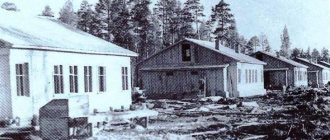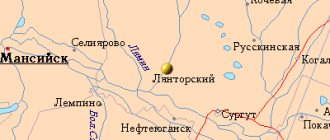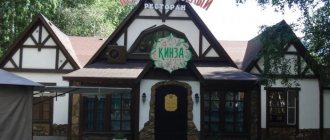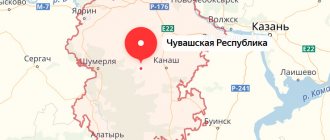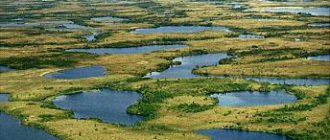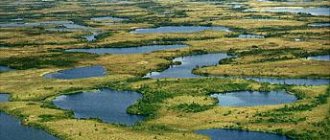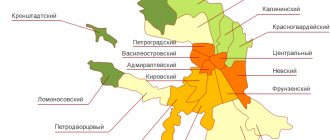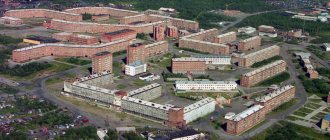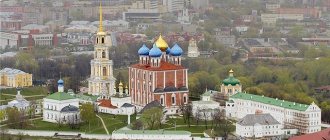This term has other meanings, see Soviet.
| City | |
| Soviet | |
| Flag | Coat of arms |
Ukrainians, Bashkirs
KatoykonimSoviet, Soviet, Soviet Digital identifiers Telephone code+7 34675 Postal code 628240, 628241, 628242 OKATO code 71124604 OKTMO code 71824104001sovinet.ru SovietMoscow
Khanty-Mansiysk
Soviet
Media files on Wikimedia CommonsSoviet
- an urban settlement in the Khanty-Mansiysk Autonomous Okrug - Ugra of Russia.
Administrative center of the Sovetsky district. Forms the city of Sovetsky
[3].
Population - 29,452[2] people. (2021), city population density 77 people/km²
Nearest cities: Khanty-Mansiysk (367 km), Nizhny Tagil (583 km), Yekaterinburg (725 km), Tyumen (1,039 km).
The Kartopya River flows through the city.
Content
- 1. History
- 2 Population
- 3 Industry
- 4 Educational institutions
- 5 Attractions
- 6 Authorities and management 6.1 History of the names of city authorities
- 6.2 History of city leaders
Sovetsky city
The modern city of Sovetsky in the Khanty-Mansi Autonomous Okrug - Ugra - continues to grow and develop. Dozens of kindergartens and schools have been built. SC "Olympus" is the pride of Soviet, which became famous throughout the world for its students, Olympic and world champions in skiing and biathlon. These are E. Dementyev, O. Melnik, D. Ustyuzhanin, S. Vatinov and A. Dotov, swimmers A. Spiridonov and T. Andreikina.
The city has its own heroes - this is A. Buzin, who was posthumously awarded the honorary title of Hero of Russia for completing a responsible task, courage and heroism.
The city is still growing. As of 2016, its population was 29 thousand people. By national composition, the majority of the city’s residents are Russians (86%), Ukrainians make up 5%, Tatars - 1.6%, Bashkirs - more than 1.5%, Belarusians - about 1.5%.
Many social enterprises have been built: shops, cafes, consumer services. Particular attention is paid to the construction of apartment buildings, which are built exclusively from stone. Dozens of well-equipped playgrounds delight little townspeople.
Story
| The style of this section is non-encyclopedic or violates the norms of the Russian language. The following section follows the stylistic rules of Wikipedia. |
In 1957
The construction of a railway connecting the Urals with the Ob Basin began in the USSR.
In March 1959, construction of the Ivdel-Ob route began[4]. First houses st.
Z. Kosmodemyanskaya The newspaper “Leninskaya Tribuna” in March 1963 described the first months of the existence of the Sovetsky village as follows: “In the dead of night in February 1962, a small detachment of builders reached the future Kartop station. Taiga greeted the scouts gloomily. A blizzard was raging, centuries-old pines were groaning from the wind. With difficulty the builders built the hut. And in the morning the first pine tree fell with a noise. The foundation of the village, which today is called Sovetsky, began. A month later, there were already 9 houses in the pine forest...”
This is how Sovetsky Kondinsky District appeared. The first streets of the city were Lesnaya and Zoya Kosmodemyanskaya. A year later, in February 1963, there were already 4 streets, a population of 1,500 people, the first train arrived in August (there were 2 carriages instead of the station building), and a timber industry enterprise was created in December.
Decision of the Executive Committee of the Tyumen Regional Council of Workers' Deputies No. 37 of January 21, 1963 (The very first document on the formation of the Soviet)
11/19/1962
In the village of Sovetsky, a post office of the Kondinsky junction appears, since together with the first builders, radio operators, telephone operators and postal workers arrived in the taiga to provide radio and telegraph communications, and the first post office appeared a year earlier in the village of Pionersky in 1961.
The first school for primary grades, “Kartopinskaya” (named after the railway station), begins work; a year later, a new school for grades 1-8 will appear on the corner of Lenin and Gastello streets, and the senior grades studied in the neighboring village of Komsomolsky (now Yugorsk). On December 20, 1962,
on the 197th km of the Ivdel-Ob railway, the Soviet Timber Industry Enterprise was created with a design capacity of 400 thousand cubic meters of wood per year.
In a couple of years, the Soviet timber industry enterprise will become a powerful enterprise (as originally planned). During the first year of work of the team of 240 people, the plan will be exceeded, 223.2 thousand cubic meters of timber will be removed.
By the decision of the Executive Committee of the Tyumen Regional Council of Workers' Deputies No. 37 of January 21, 1963 “On classifying the villages of Komsomolsky and Sovetsky of the Kondinsky district of the Khanty-Mansiysk National Okrug to the category of urban-type working villages, the formation of the Komsomolsky and Sovetsky village Councils and the abolition of the Komsomolsky Village Council” the village Sovetsky is classified as an urban-type working settlement. The village Council of Workers' Deputies was formed.
October 1, 1963
The Soviet SMU of the Tyumenlesstroy trust is formed. For many years, this enterprise will carry out the construction of logging roads, lower warehouses, sawmills and non-production facilities. The cinema "Luch" started operating.
June 1965
The Soviet district hospital began operating (since 1968 - the Soviet district hospital).
The first chief physician was G. A. Bykov. The first building was located at Gastello no. 1. On January 1, 1969, the number of employees will be 70 people, of which 5 are doctors, 38 are paramedical personnel. The first kindergarten in the city “Teremok” was built (which will begin its work in April 1966)
August 1965.
A new bakery was launched on the street. Lenin with mechanized sifting of flour and kneading dough.
The first bakery was built in 1963 on the corner of Lenina and Lesnaya streets, where all the work was done by hand (water was carried from wells, the oven was heated with wood)
01.11.1966
By order of the head of the Serov branch of the Sverdlovsk Railway, the Kartopya railway station was renamed to the Verkhnekondinskaya railway station. At this time, the number of employees was 32 people.
In 2000, the station staff will receive the title “Best Staff of the Sverdlovsk Railway”.
1967
The first library in the village opens under the leadership of N. A. Tortyna.
02/15/1968
In accordance with the Decree of the Presidium of the Supreme Council of the RSFSR, the Sovetsky district was formed as part of the Khanty-Mansiysk National Okrug, which included the workers’ villages of Komsomolsky, Pionersky, and Sovetsky. Since 1968, Sovetsky began to develop intensively, becoming the center of a large timber industry region.
1968
The Soviet children's music school opened.
May 1968
The Sovetsky airport, which is the same age as the Sovetsky district, was opened and was founded as a structural unit of the Tyumen United Air Squadron.
The number of employees was 10 people, including the chief P.A. Pavlenko (in December 1991, the number of employees would reach 211 people). Cargo work was carried out by Mi-4, Mi-1, and later Mi-8 and Mi-2 helicopters; passenger transportation was carried out by An-2 and Li-2 aircraft. All airport services were housed in one trailer, and in the fall of the same year the terminal building was built and new services appeared, such as ATC, SOP, ERTOS, fuel and lubricants, SST. In 1985, construction of the runway will begin. An aviation department for forest protection was opened (from 1982 to 1990, the Soviet aviation department for forest protection will take prizes in socialist competitions of air departments of the Tyumen air base)
[5]
Film for the 50th anniversary of the Soviet Airport.
June 10, 1968
. A district department of internal affairs was formed. During the year of operation of the Department of Internal Affairs, 64 crimes will be recorded throughout the region (2 murders, 3 serious bodily injuries, 9 thefts of government property, 8 thefts of personal property, 16 cases of hooliganism). The detection rate was 93.9%.
August 15, 1968
The first issue of the newspaper “The Path of October” was published (by the early 90s, the circulation would reach 15 thousand when published twice a week).
1969
The two-story and comfortable hotel “Taiga” began work on the street. Lenin (which will be destroyed by fire on March 18, 2012).
1972
In August, a memorial complex was opened in the center of Sovetsky. Capsules with an appeal from young people to the future generation were immured in it (capsules should be opened in 2022). In October, the dairy began operating, providing social institutions with milk, kefir, sour cream and cottage cheese, producing up to 700 tons of products annually.
at the anniversary exhibition of the 70th anniversary of the Khanty-Mansi Autonomous Okrug, in December 2000, the Soviet Dairy Plant will take 3rd place among the food industry enterprises of the district. At that time, 25 people worked at the plant, the director was M. A. Gracheva.
April 30, 1971
On the territory of the Sovetsky and Kondinsky districts, the Verkhne-Kondinsky state nature reserve was created, which is a specially protected natural area of federal significance with an area of 241.6 thousand hectares. Within the reserve are the upper reaches of the Konda, the Ess, Eytya, Ukh, and Nyurikh rivers. Rare pure white and tetrahedral water lilies grow on the territory. Since 1977, the reserve will be subordinate to the Malaya Sosva nature reserve.
1978
A gas pipeline was laid from the village of Komsomolsky (now Yugorsk) to the boiler house of the Soviet LDK. Gasification of residential buildings in the city has begun.
1979
A gym for boxing classes “Ring-80” has been opened (name in honor of the Moscow Olympics)
The first classes of the section began in 1972 in the basement of the Green Light railway club. The first brothers to start working there were the Nosovs, Zhukovs, and Misyukevichs, the children of loggers and railroad workers.
1982
The swimming pool has opened. In three years, the team from Sovetsky will become the champion of the All-Russian Rural Games in Stavropol.
1983
OJSC "Soviet Motor Transport Enterprise" of Severavtotrans was created as a branch of the Urai ATP. From 1986 to 1990 will be a branch of the Nyagan ATP, and then an independent enterprise.
April 1984
In the village of Sovetsky, the construction organization SU No. 881 of the Tyumendorstroy trust appeared, which built a concrete runway in 1987 (construction lasted 2 years), roads with concrete pavement, and residential buildings. The first boss was G. G. Kadochnikov. In 2001, under contracts totaling 160 million rubles, the Sovetsky-Yugorsk-Taezhny and Urai-Sovetsky highways will be put into operation.
November 21, 1989
An-24B
crashed , killing 32 people.
As of January 1, 1990, in the Sovetsky district there were 8 workers’ villages (Agirish, Zelenoborsk, Kommunistichesky, Komsomolsky, Malinovsky, Pionersky, Sovetsky, Tayozhny) and one village council (Alyabyevsky).
July 1990
The first episodes of TV programs have been released.
On November 26, 1990,
on the initiative of Sovetsky resident V.G. Maltseva, the first community of believers was created. Fundraising began for the construction of the temple (the construction of which will begin in 1993)
In the summer of 1999, as part of the “For Faith and Fidelity” movement, a memorial cross was erected at the “Mother’s Order” memorial by an all-Russian religious procession.
1993
The “Chance” youth social adaptation center has been opened. One of the first youth labor exchanges in Khanty-Mansi Autonomous Okrug.
12/12/1993
A retail store (sales area 905 m²), owned by Rubin LLC, began operating and participated in all social programs of the district administration (helped war veterans, disabled people, children's rehabilitation for free).
02/01/1994
A charity club for disabled children “Solnyshko” has been opened
1995
CJSC Stroymontazh was founded. The first 4 years worked in the field of civil engineering: a school in Malinovsky for 200 students, the Malachite store in Yugorsk, an evening school in Sovetsky for 500 students, the veterinary service building in Sovetsky, the Iceberg nightclub in Yugorsk.
12/16/1996
The Duma of the Khanty-Mansi Autonomous Okrug adopted and signed the law “On classifying the urban-type settlement Sovetsky as a city of district significance.” In accordance with the Law of the Khanty-Mansi Autonomous Okrug “On classifying the city of Yugorsk as a city of district significance,” the city of Yugorsk is leaving the Sovetsky district.
12/23/1996
Sovetsky was transformed from a workers' village into a city
December 1997
Remdorstroy LLC was created, which is engaged in the construction and reconstruction of highways of all categories and purposes, production of building materials and structures, and freight transportation. In 4 years, roads will be built to the villages of Pionersky, Alyabyevsky, Malinovsky, Tayozhny, as well as the roads Yubileiny - Tayozhny, Pionersky - Malinovsky, Sovetsky - Zelenoborsk (a total of 113 km of roads and 137 meters of bridges)
1999
A children's public pioneer organization has been created in the city, uniting 4 thousand students in grades 2-8. In 2002, the Sovetsky district became the record holder among the municipalities of Khanty-Mansi Autonomous Okrug-Yugra for the commissioning of individual housing. In the city of Sovetsky, 8,000 m2 of individual housing were built during this year.
May 2002
The subsidiary farm of the city of Sovetsky, previously owned by Sovetskles LLC, became a municipal enterprise containing 1020 heads of pigs, 59 heads of cattle, including 15 cows. The number of employees is 25 people, the annual production is 47 tons of pork, 19 tons of beef and 40 tons of milk. Products were directly supplied to healthcare, education and social protection institutions.
October 16, 2002
The grand opening of the Grand supermarket took place, which, thanks to its technical capabilities, was the most modern in the area.
February 2003
An equestrian sports section began operating; at the time of opening there were 8 horses.
01/11/2006
In accordance with Federal Law No. 131-FZ dated October 6, 2003 “On the general principles of organizing local self-government in the Russian Federation,” the city of Sovetsky is an urban settlement. The Administration of the urban settlement of Sovetsky was formed. The administration of the city of Sovetsky was liquidated.[6][4]
03/12/2018
. In the maternity hospital of the Sovetskaya District Hospital, the 30,000th resident of the city of Sovetsky was born into the family of Landysh and Alexei Zaitsev[7].
September 16, 2019
The grand opening of the alley took place on the street. Kyiv.
Post-Soviet period
Surprising as it may seem, the post-Soviet period, which hit the industrial regions of the Russian North hard, where many villages and cities turned into “ghosts”, having lost a significant part of the population who left for the mainland, practically did not affect the population of the Soviet Khanty-Mansiysk Autonomous Okrug (you see a photo of this region in the article). The number of residents continued to grow, and in 1996 it amounted to 20,000 people.
In the same year, a decision was made to classify the village of Sovetskoye as a city of regional significance. The city of Yugorsk is removed from the Sovetsky district and classified as a city of district significance.
Population
| Population | |||||||
| 1970[8] | 1979[9] | 1989[10] | 1996[10] | 2000[10] | 2001[10] | 2002[11] | 2003[10] |
| 5897 | ↗13 674 | ↗21 100 | ↘20 900 | ↗22 200 | ↗22 900 | ↗23 230 | ↘23 200 |
| 2005[10] | 2006[10] | 2007[10] | 2008[12] | 2009[13] | 2010[14] | 2011[10] | 2012[15] |
| ↗24 500 | ↗24 800 | ↗25 200 | ↗25 600 | ↗25 974 | ↗26 495 | ↗26 500 | ↗27 116 |
| 2013[16] | 2014[17] | 2015[18] | 2016[19] | 2017[20] | 2018[21] | 2019[22] | 2020[23] |
| ↗27 631 | ↗28 087 | ↗28 683 | ↗29 179 | ↗29 456 | ↗29 575 | ↗29 624 | ↘29 293 |
| 2021[2] | |||||||
| ↗29 452 | |||||||
As of January 1, 2022, in terms of population, the city was in 509th place out of 1,116[24]cities of the Russian Federation[25].
Attractions
- Mother's order
- Tank monument and city park
- Bypass road bridge. A traditional place for school graduates to meet the dawn.
- Stele
- Pioneer Monument
- An-2 aircraft. An-2 aircraft made a great contribution to the development of the district and small aviation of the country.
- Soviet Regional Museum and Exhibition Center[26]
- Lonely pine An integral symbol of the returning residents of the city, of all generations. It was destroyed during the reconstruction of the route in 2020.
Authorities and management
History of the names of city authorities
Name of city government
| date | Name |
| from 01/21/1963 | Executive Committee of the Soviet Village Council of Workers' Deputies of the Kondinsky District. |
| from 02/15/1968 | Executive Committee of the Sovetsky Village Council of Workers' Deputies of the Sovetsky District. |
| from 07.10.1977 | Executive Committee of the Sovetsky Village Council of People's Deputies of the Sovetsky District. |
| from 12/26/1991 | Administration of the village of Sovetsky, Sovetsky district. |
| from 12/23/1996 | Administration of the city of Sovetsky, Sovetsky district. |
| from 11/18/1998 to 05/25/2006 | Administration of the city of Sovetsky[27] |
| from 11.01.2006 | Administration of the urban settlement Sovetsky[27] |
History of city leaders
heads of villages and cities
| Dates | Full name, position |
| 05.03.1963 24.02.1964 | Surodeev Ivan Petrovich. Chairman of the Executive Committee of the Soviet Village Council of Workers' Deputies of the Kondinsky District |
| 24.02.1964 07.04.1964 | Fomina Apolinaria Kirillovna. Chairman of the Executive Committee of the Soviet Village Council of Workers' Deputies of the Kondinsky District |
| 07.04.1964 15.03.1965 | Bannikova Valentina Ivanovna. Chairman of the Executive Committee of the Soviet Village Council of Workers' Deputies of the Kondinsky District |
| 15.03.1965 14.03.1967 | Kuklyuk Nikolay Ulyanovich. Chairman of the Executive Committee of the Soviet Village Council of Workers' Deputies of the Kondinsky District |
| 14.03.1967 26.12.1967 | Surodeev Ivan Petrovich. Chairman of the Executive Committee of the Soviet Village Council of Workers' Deputies of the Kondinsky District |
| 25.12.1967 27.04.1968 | Shutko Galina Gavrilovna. And about. Chairman of the Executive Committee of the Soviet Village Council of Workers' Deputies of the Kondinsky District |
| 28.04.1968 16.06.1971 | Grozin Moisey Antropovich. Chairman of the Executive Committee of the Sovetsky Village Council of Workers' Deputies of the Sovetsky District |
| 16.06.1971 19.06.1975 | Arkanov Petr Stepanovich. Chairman of the Executive Committee of the Sovetsky Village Council of Workers' Deputies of the Sovetsky District |
| 19.06.1975 22.06.1982 | Belousov Pyotr Makarovich. Chairman of the Executive Committee of the Sovetsky Village Council of Workers' Deputies of the Sovetsky District |
| 22.06.1982 05.01.1987 | Safronov Valentin Artemyevich. Chairman of the Executive Committee of the Soviet Village Council of People's Deputies |
| 11.02.1987 28.12.1988 | Karpenko Valentina Pavlovna. Chairman of the Executive Committee of the Soviet Village Council of People's Deputies |
| 28.12.1988 16.05.1990 | Pertsev Vitaly Vasilievich. Chairman of the Executive Committee of the Soviet Village Council of People's Deputies |
| 16.05.1990 06.09.1990 | Derevianko Taisiya Fedorovna. Chairman of the Executive Committee of the Soviet Village Council of People's Deputies |
| 06.09.1990 21.09.1996 | Marushkin Alexander Nikolaevich. Chairman of the Executive Committee of the Soviet Village Council of People's Deputies |
| 2001 24.08.2006 | Grigoriev Vyacheslav Alekseevich. Head of the urban settlement Sovetsky |
| 25.08.2006 20.10.2008 | Pyankov Sergey Viktorovich. Acting Head of the urban settlement Sovetsky |
| 31.10.2008 14.11.2012 | Mitrofanov Ilya Petrovich. Head of the urban settlement Sovetsky |
| 15.11.2012 22.09.2016 | Savintsev Alexey Vladimirovich. Head of the urban settlement Sovetsky |
| 28.09.2016 22.09.2020 | Zhukov Alexander Yurievich. Head of the urban settlement Sovetsky |
| 23.09.2020 to date | Kulagin Alexander Terentievich. Head of the urban settlement Sovetsky |
Transport
There is a Sovetsky airport in Sovetsky, the main activity of which is helicopter communication with northern villages that do not have a highway. Flights Sovetsky - Beloyarsky, Sovetsky - Moscow (Vnukovo), Sovetsky - Tyumen, Sovetsky - Yekaterinburg are also regularly operated. Since May 2016, flights have also been operated on the route Sovetsky - St. Petersburg, where the carrier is Severstal Airlines. The railway station is called Verkhnekondinskaya.
Climate
The city of Sovetsky is equated to the regions of the Far North. The climate is temperate continental, characterized by rapid changes in weather conditions, especially in autumn and spring, as well as during the day. The record minimum was −48° recorded in February 1994. The record maximum was +38° in June 2012.
Average temperatures in Sovetsky
| average minimum temperature | average maximum temperature | |
| January | −36 | −15 |
| February | −20 | −13 |
| March | −13 | −4 |
| April | −7 | 2 |
| May | 1 | 11 |
| June | 9 | 19 |
| July | 13 | 22 |
| August | 10 | 18 |
| September | 4 | 11 |
| October | −4 | 2 |
| november | −14 | −8 |
| December | −34 | −13 |
Geography
The Sovetsky district is equated to the regions of the Far North.
Located on the North Sosvinskaya Upland. The southern part of the district extends beyond the Kondinskaya Lowland. The territory of the district is 30.1 thousand km².
In terms of area, the Sovetsky district exceeds such Russian republics as: Chuvashia (18.3 thousand sq. km), Mordovia (26.2 thousand sq. km), Mari El (23.2 thousand sq. km) and others; regions of Russia: Vladimir (29.0 thousand sq. km), Kursk (29.8 thousand sq. km), Tula (25.7 thousand sq. km), Belgorod (27.1 thousand sq. km) and others. The area is comparable in area to the following states: Moldova (33 thousand sq. km), Belgium (30.5 thousand sq. km), Armenia (29.8 thousand sq. km). Located in the V time zone.
The hydrographic network of the region belongs to the basins of the Northern Sosva and Konda rivers.
The distance from Sovetsky to Khanty-Mansiysk is 340 kilometers; the distance to Moscow is 1752 kilometers.
The district borders: in the north - with the Berezovsky district; in the east - with the Oktyabrsky district; in the southeast - with the Kondinsky district; in the west - with the Sverdlovsk region.
Famous athletes-pupils of the Soviet regional Youth Sports School
- Evgeniy Dementyev is an Olympic champion, silver medalist of the World Relay Championship, winner and medalist of the World Cup stages.
- Olga Melnik is an Honored Master of Sports of the Russian Federation, champion of Russia, three-time medalist of the world championships, silver medalist of the Olympic Games in Nagano in biathlon.
- Denis from Ustyuzhan is the champion of Russia in cross-country skiing.
- Sergei Votinov, Alexander Dutov are Russian champions in biathlon among juniors.
- Spiridonov Alexander - silver medalist of the Russian Swimming Cup, winner and medalist of the Russian Swimming Championship, champion of the All-Russian swimming competitions.
- Tatyana Andreikina is a champion of the All-Russian swimming competition.
- S. Melnikov - twice 3rd place in the World Armwrestling Championships in 1999 in Tokyo and 2000 in Finland.
- Andrei Sizikov, Andrei Volkov are medalists of the biathlon world championships.
An excerpt characterizing the Sovetsky region (Khanty-Mansiysk Autonomous Okrug)
When Pierre left and all the family members came together, they began to judge him, as always happens after the departure of a new person, and, as rarely happens, everyone said one good thing about him. Returning this time from vacation, Rostov felt and learned for the first time how strong his connection was with Denisov and with the entire regiment. When Rostov drove up to the regiment, he experienced a feeling similar to the one he experienced when approaching the Cook's House. When he saw the first hussar in the unbuttoned uniform of his regiment, when he recognized the red-haired Dementyev, he saw the hitching posts of red horses, when Lavrushka joyfully shouted to his master: “The Count has arrived!” and shaggy Denisov, who was sleeping on the bed, ran out of the dugout, hugged him, and the officers came to the newcomer - Rostov experienced the same feeling as when his mother, father and sisters hugged him, and the tears of joy that came to his throat prevented him from speaking . The regiment was also a home, and the home was invariably sweet and dear, just like the parental home. Having appeared before the regimental commander, having been assigned to the previous squadron, having gone on duty and foraging, having entered into all the small interests of the regiment and feeling himself deprived of freedom and shackled into one narrow, unchanging frame, Rostov experienced the same calm, the same support and the same consciousness the fact that he was at home here, in his place, which he felt under his parents’ roof. There was not all this chaos of the free world, in which he did not find a place for himself and made mistakes in the elections; there was no Sonya with whom it was or was not necessary to explain things. There was no option to go there or not to go there; there were no 24 hours of the day that could be used in so many different ways; there was not this countless multitude of people, of whom no one was closer, no one was further; there were no these unclear and uncertain financial relations with his father, there was no reminder of the terrible loss to Dolokhov! Here in the regiment everything was clear and simple. The whole world was divided into two uneven sections. One is our Pavlograd regiment, and the other is everything else. And there was nothing else to worry about. Everything was known in the regiment: who was the lieutenant, who was the captain, who was a good person, who was a bad person, and most importantly, a comrade. The shopkeeper believes in debt, the salary is a third; there is nothing to invent or choose, just don’t do anything that is considered bad in the Pavlograd regiment; but if they send you, do what is clear and distinct, defined and ordered: and everything will be fine. Having entered again into these certain conditions of regimental life, Rostov experienced joy and tranquility, similar to those that a tired person feels when he lies down to rest. This regimental life was all the more gratifying for Rostov during this campaign because, after losing to Dolokhov (an act for which he, despite all the consolations of his family, could not forgive himself), he decided to serve not as before, but in order to make amends, to serve well and to be a completely excellent comrade and officer, that is, a wonderful person, which seemed so difficult in the world, but so possible in the regiment. Rostov, from the time of his loss, decided that he would pay this debt to his parents in five years. He was sent 10 thousand a year, but now he decided to take only two, and give the rest to his parents to pay off the debt. Our army, after repeated retreats, offensives and battles at Pultusk, at Preussisch Eylau, concentrated near Bartenstein. They were awaiting the arrival of the sovereign to the army and the start of a new campaign. The Pavlograd regiment, which was in that part of the army that was on the campaign in 1805, was recruited in Russia, and was late for the first actions of the campaign. He was neither near Pultusk nor near Preussisch Eylau, and in the second half of the campaign, having joined the active army, he was assigned to Platov’s detachment. Platov's detachment acted independently of the army. Several times the Pavlograd residents were in units in skirmishes with the enemy, captured prisoners and once even recaptured the crews of Marshal Oudinot. In April, Pavlograd residents stood for several weeks near an empty German village that had been destroyed to the ground, without moving. There was frost, mud, cold, the rivers were broken, the roads became impassable; For several days neither the horses nor the people were given provisions. Since delivery became impossible, people scattered across abandoned desert villages to look for potatoes, but they found little of that. Everything was eaten, and all the inhabitants fled; those who remained were worse than beggars, and there was nothing to take from them, and even little - compassionate soldiers often, instead of taking advantage of them, gave them their last. The Pavlograd regiment lost only two wounded in action; but lost almost half of the people from hunger and disease. They died so surely in hospitals that soldiers, sick with fever and swelling resulting from bad food, preferred to serve, dragging their feet to the front rather than go to hospitals. With the opening of spring, the soldiers began to find a plant emerging from the ground, similar to asparagus, which they called for some reason Mashkin’s sweet root, and they scattered across the meadows and fields, looking for this Mashkin’s sweet root (which was very bitter), dug it up with sabers and ate it, despite to orders not to eat this harmful plant. In the spring, a new disease appeared among the soldiers, swelling of the arms, legs and face, the cause of which doctors believed was the use of this root. But despite the ban, the Pavlograd soldiers of Denisov’s squadron ate mainly Mashka’s sweet root, because for the second week they were stretching out the last crackers, they were only given half a pound per person, and the potatoes in the last parcel were delivered frozen and sprouted. The horses had also been eating thatched roofs from houses for the second week; they were hideously thin and covered with tufts of matted winter hair.
Notes
- Database of indicators of municipalities (Tyumen region)
- ↑ 123
The permanent population of the Russian Federation by municipalities as of January 1, 2022 (Russian). Retrieved April 27, 2022. Archived May 2, 2022. - Law of the Khanty-Mansiysk Autonomous Okrug - Ugra dated November 25, 2004 No. 63-oz “On the status and boundaries of municipalities of the Khanty-Mansiysk Autonomous Okrug - Ugra”
- ↑ 1 2 Bespalova T. L. et al.
My address is Sovetsky district. - Ekaterinburg. - U-Factoria, 2003. - 316 p. - Sovetsky Airport (unspecified)
.
official site
. - City administration.
History of the city of Sovetsky
(undefined)
.
website of the City Administration of Sovetsky
(02.11.2009). - We meet the 30,000th resident of Sovetsky Alisa Zaitseva News Agency “2 Cities”
- All-Union Population Census of 1970 The size of the urban population of the RSFSR, its territorial units, urban settlements and urban areas by gender. (Russian). Demoscope Weekly. Access date: September 25, 2013. Archived April 28, 2013.
- All-Union Population Census of 1979 The size of the urban population of the RSFSR, its territorial units, urban settlements and urban areas by gender. (Russian). Demoscope Weekly. Access date: September 25, 2013. Archived April 28, 2013.
- ↑ 123456789
People's encyclopedia "My City". Sovetsky (Khanty-Mansiysk Autonomous Okrug) - All-Russian population census 2002. Volume. 1, table 4. Population of Russia, federal districts, constituent entities of the Russian Federation, districts, urban settlements, rural settlements - regional centers and rural settlements with a population of 3 thousand or more (unspecified)
. Archived from the original on February 3, 2012. - Cities of the Khanty-Mansiysk Autonomous Okrug - Ugra (number of inhabitants - estimate as of January 1, 2008, thousand people) (unspecified)
. Retrieved July 11, 2016. Archived July 11, 2016. - The size of the permanent population of the Russian Federation by cities, urban-type settlements and regions as of January 1, 2009 (unspecified)
. Retrieved January 2, 2014. Archived January 2, 2014. - All-Russian population census 2010. Population size and its distribution in the Tyumen region (unspecified)
. Retrieved May 10, 2014. Archived May 10, 2014. - Population of the Russian Federation by municipalities. Table 35. Estimated resident population as of January 1, 2012 (unspecified)
. Retrieved May 31, 2014. Archived May 31, 2014. - Population of the Russian Federation by municipalities as of January 1, 2013. - M.: Federal State Statistics Service Rosstat, 2013. - 528 p. (Table 33. Population of urban districts, municipal districts, urban and rural settlements, urban settlements, rural settlements) (undefined)
. Retrieved November 16, 2013. Archived November 16, 2013. - Table 33. Population of the Russian Federation by municipalities as of January 1, 2014 (unspecified)
. Access date: August 2, 2014. Archived August 2, 2014. - Population of the Russian Federation by municipalities as of January 1, 2015 (unspecified)
. Access date: August 6, 2015. Archived August 6, 2015. - Population of the Russian Federation by municipalities as of January 1, 2016 (Russian) (October 5, 2018). Retrieved May 15, 2022. Archived May 8, 2022.
- Population of the Russian Federation by municipalities as of January 1, 2022 (Russian) (July 31, 2017). Retrieved July 31, 2022. Archived July 31, 2022.
- Population of the Russian Federation by municipalities as of January 1, 2022 (Russian). Retrieved July 25, 2018. Archived July 26, 2022.
- Population of the Russian Federation by municipalities as of January 1, 2022 (Russian). Retrieved July 31, 2019. Archived May 2, 2022.
- Population of the Russian Federation by municipalities as of January 1, 2022 (Russian). Date accessed: October 17, 2022. Archived October 17, 2022.
- taking into account the cities of Crimea
- https://rosstat.gov.ru/storage/mediabank/bul_Chislen_nasel_MO-01-01-2021.rar Population of the Russian Federation by municipalities as of January 1, 2022 (1.85 Mb, 07/30/2021)
- Soviet Regional Museum and Exhibition Center - official website of "Culture.RF", Khanty-Mansiysk Autonomous Okrug - Yugra. Address, photo, schedule, work schedule (unspecified)
. www.culture.ru. Date accessed: May 13, 2022. - ↑ 12
territorial division of the Administration of the municipal formation of the Sovetsky district, Khanty-Mansiysk Autonomous Okrug, Tyumen region
Where is it located?
The city of Sovetsky, Khanty-Mansi Autonomous Okrug, is located in the center of the West Siberian Plain. Its entire territory is located in the taiga forest zone, where pine, fir, cedar, spruce and larch trees predominate. There are areas where the taiga is very swampy. Pine forests alternate with dark coniferous forests growing in wetlands. The forests are rich in taiga vegetation and berries: cloudberries, raspberries, cranberries, currants, blueberries, blueberries.
The closest city of Sovetsky in the Khanty-Mansiysk Autonomous Okrug is located to the city of Yugorsk - only 15 km; the distance to Khanty-Mansiysk is 367 kilometers. Other nearby cities are located at a considerable distance: Nizhny Tagil - 583 km, Ekaterinburg - 725 km, Tyumen - 1039 km.
